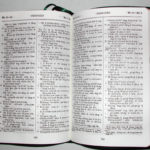Did you know that the New Testament has different divisions? Learn how the 27 books of the New Testament are arranged.
Sixty-Six Books
You may know that there is a New Testament and an Old Testament contained in the Bible, but did you know there are sub-divisions within each of the Testaments of the Bible? The New Testament has twenty books in all while the Old Testament has thirty-nine books. Together, there are sixty-six books in the Bible. For now, we will examine how each of the twenty-seven books of the New Testament is arranged and categorized within the Bible. [1]
[1]
The Gospels
There are 4 writers of the gospel, so there are 4 accounts of the life, death, and resurrection of Jesus Christ in the New Testament. The word “Gospel” in Greek is evangelion, which means “good news.” While many Christians believe these books are historical, these Gospel “biographies” are not arranged in chronological order as modern biographies are. Each Gospel gives us a different aspect of Jesus and a different theological emphasis. It’s like having 4 eye-witnesses watching something and recording it in their own way, however the events are not necessarily structured linearly, but around a theme that the writer is conveying.
The Synoptic Gospels
The first 3 Gospels are Matthew, Mark, and Luke. These are called the “synoptic” gospels (literally meaning “seeing together”). These 3 Gospels are called Synoptic Gospels because of their general similarity. The Gospel of John leaves out some of the material discussed in the Synoptics but gives us details that are not provided in the first 3 Gospels. There is a great deal of scholarship dealing with the dating of the Gospels, and all the New Testament books. The dates vary greatly from scholar to scholar as certain assumptions must be made. From a conservative Christian standpoint, the periods for these writings range from roughly 50 A.D. to 65 A.D.
Below are listed the 4 Gospels and possible dates of writing:
1. Matthew: 50-60’s A.D.
2. Mark: 50-70 A.D.
3. Luke: 59 – 70’s A.D.
4. John: 50’s – 85 A.D.
The Historical Book of Acts
The only book of “history” is the book of Acts in the New Testament, although scholars also include the Gospel of Luke, who wrote both of these books. It is the second book that Luke authored, which includes his Gospel. The focus of the Book of Acts begins with the ministry of the Holy Spirit through the Apostle Peter and the church. Then the focus changes to the ministry of the Apostle Paul. It is a narrative of the spread and growth of the Christian Church through the Gospel and the Holy Spirit in the ancient world.
The Pauline Epistles
Paul wrote thirteen “Epistles” or letters that are contained in New Testament Scripture. In his epistles, Paul expounds on the Old Testament Scriptures and explains the meaning of the life, death, and resurrection of Jesus Christ for the Church. Many of Paul’s epistles were meant to be read aloud to the congregations they were addressed to and, in some cases, exchanged with other Christian congregations to be read (cf. I Thess. 5:27; Col. 4:26). In the eighteenth century a further sub-division of Paul’s epistles was made — the Pastoral Epistles. The Pastoral Epistles include 1 & 2 Timothy and Titus.
Here is the list of Paul’s 13 Epistles:
1. Romans
2. 1 Corinthians
3. 2 Corinthians
4. Galatians
5. Ephesians
6. Philippians
7. Colossians
8. 1 Thessalonians
9. 2 Thessalonians
10. 1 Timothy (Pastoral Epistle)
11. 2 Timothy (Pastoral Epistle)
12. Titus (Pastoral Epistle)
13. Philemon
The General or “Catholic” Epistles
While the Pauline Epistles are addressed to specific congregations or persons, they are really addressed to the “general” or Catholic Church; the Christian Church universal. “Catholic” in this context is not referring to the “Roman Catholic Church” but “catholic” in the sense of “universal” or “worldwide.” Therefore these 7 letters are titled according to the author’s name. Since the time of Eusebius (c. 265 – 340 A.D.), these letters have been classified as the General or Catholic Epistles, being read and accepted by the Church as Scripture. Regarding the Book of Hebrews, the author remains anonymous, so the Book of Hebrews was not historically grouped with these other 7 books by Paul. There is strong evidence of late that this book was actually was written by the Apostle Paul (Heb 2:3-4, 13:22), but it was originally written in Hebrew for the Jews in the Church. Only later would it translated into Greek. Naturally we know that all Scripture is God-breathed as God used authors as a means to write His Word (2 Tim 3:16-17).

Hebrews and the 7 General or Catholic Epistles are listed below:
1. Hebrews (historically grouped with the Pauline Epistles)
2. James
3. 1 Peter
4. 2 Peter
5. 1 John
6. 2 John
7. 3 John
8. Jude
The Apocalyptic Book of Revelation
The title “Revelation” means an unveiling or revealing. It is a book of prophecy. The Book of Revelation focuses on the “revelation” of Jesus Christ’s to the Apostle John, and ultimately to the church and the world (Rev 1:7). Even though it was not written chronologically, this book focuses on the triumph of Jesus Christ, the end of the world as we know it, and the New Heavens and the New Earth (Rev 21, 22). Like the New Testament Book of Acts, the Book of Revelation is in a category by itself. The Book of Revelation is the only book in the New testament that is apocalyptic, similar to the Book of Daniel. The Book of Revelation has been historically attributed to St. John the Apostle and contains the visions he saw of the future of the world, the judgment of sinners, the final consummation of the Kingdom of God, the Second Coming of Jesus Christ, and the reign of Jesus Christ.
 [3]New Testament Divisions
[3]New Testament Divisions
● Gospels:
Matthew, Mark, Luke and John.
● Pauline Epistles:
Romans, 1 & 2 Corinthians, Galatians, Ephesians, Philippians, Colossians, 1 & 2 Thessalonians, 1 & 2 Timothy, Titus, Philemon, [Hebrews?].
● General or “Catholic” Epistles:
Hebrews, James, 1 & 2 Peter, 1-3 John, Jude.
● Revelation or Prophecy:
Revelation.
Having a basic understanding of the major divisions of New Testament books will help guide your Bible reading and give you further insight into the books of the Bible you are studying.
Here is some related reading for you: How Did the Bible Get It’s Name? What Does the Word Bible Mean? [4]
Resource – Scripture quotations are from The Holy Bible, English Standard Version® (ESV®), Crossway Bibles. (2007). ESV: Study Bible: English standard version. Wheaton, Ill: Crossway Bibles. Used by permission. All rights reserved.
About the Author: John J. Gregg is an experienced essay writer on Essay Writer.Nyc [5], where he provides students with an opportunity to get higher grades. The author is also fond of reading and playing the guitar. By the way, John dreams of traveling a lot and visiting as many countries as possible.


